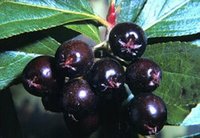Of course, it's not just a mix of blueberry and pomegranate juices. In fact, down in the corner of the label, in small type, it says "Flavored 4 Juice Blend From Concentrate." Reading the ingredients, I see that it contains filtered water, apple juice concentrate, pomegranate juice concentrate, aronia berry concentrate, blueberry juice concentrate and a handful of chemicals.
"Aronia berry concentrate"? What the **** is an aronia berry?
 See here, or here. Aronia melanocarpa (aka Photinia melanocarpa - pick a taxon, any taxon), the black chokecherry, is a woody shrub of the family Rosaceae, native to eastern North America. According to the folks at WSU, the plants grow to six to eight feet tall, and landscapers like them for their "clusters of creamy white flowers in late spring, and colorful flame-colored autumn foliage contrasting with dark berries."
See here, or here. Aronia melanocarpa (aka Photinia melanocarpa - pick a taxon, any taxon), the black chokecherry, is a woody shrub of the family Rosaceae, native to eastern North America. According to the folks at WSU, the plants grow to six to eight feet tall, and landscapers like them for their "clusters of creamy white flowers in late spring, and colorful flame-colored autumn foliage contrasting with dark berries."From WSU (the first site linked to above):
The commercial use of aronia is mainly for juice, either alone or blended with other fruit juices such as grape or apple. Other reported uses are for syrup, tea, soft spreads and food coloring. Aronia juice and juice blends are commercially marketed, such as Wildland Aronia Juice (available at supermarkets), R. W. Knudson's Mega C and others. One innovative introduction is a dry sparkling beverage, Aronia Cassis, produced by Riggs & Forsythe as a nonalcoholic adult alternative to soda pop. The main source for juice at present seems to be fruit grown in Europe, though the Cornell report mentions a small (unnamed) commmercial grower in Oregon. Test plantings have also been established by the USDA's Plant Materials Program at 11 sites in North Dakota, South Dakota and Minnesota.
Interest in the health benefits of aronia juice is based on its very high levels of anthocyanins and flavonoids, five to ten times higher than cranberry juice, with beneficial nutrients such as antioxidants, polyphenols, minerals and vitamins, that may include compounds that specifically fight cancer and cardiac disease. Dr. David Siegler at the University of Illinois is presently engaged in research to evaluate the health potential of aronia. Other research by Dr. Bernadine Strik at Oregon’s North Willamette Research Station involves testing of a number of aronia varieties to determine the ones that perform best in quality and production.
Fruit consultant Lon Rombough reports that in Russia, aronia and apple juices are combined and fermented to produce red wine. In Lithuania prize winning dessert wines have been made using aronia juice, alone or blended with other fruits. Tom Plocher at Minnesota has been experimenting with aronia as a blending agent to improve the color, tannin level and sugar of grape wines (aronia has measured up to 24 brix when fully ripe.) Plocher has been trying a European technique to graft aronia onto sorbus trunks to raise the fruiting area up higher for ease of picking. With fruit from the Mount Vernon trials, Drew Zimmerman of the Northwest Cider Society successfully used a blend of aronia and apple juice for a test production of hard (fermented) cider, and we look forward to results of his further trials.
Fascinating....











No comments:
Post a Comment